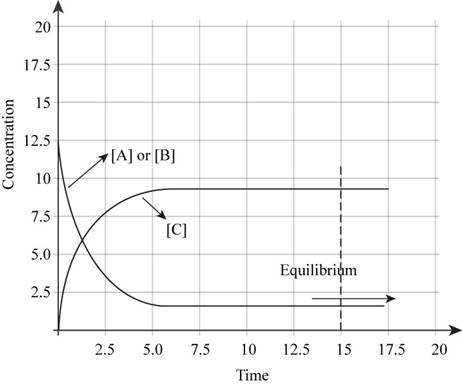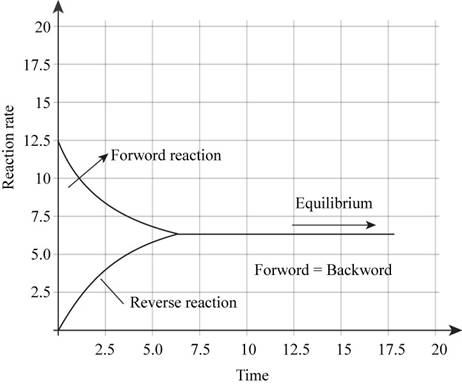
Characterize a system at
a. the rates of the forward and reverse reactions
b. the overall composition of the reaction mixture For a general reaction
Interpretation: The given systems at equilibrium are to be characterized. For the given reaction, the required plot is to be shown. The plot that illustrates the rate of forward reaction and rate of reverse reaction is to be sketched.
Concept introduction: Chemical equilibrium is a state of a system in which the rate of forward reaction and that of the backward reaction is equal. It is affected by various factors such as concentration of reactants or products, temperature, pressure.
Answer to Problem 1RQ
Answer
- a) Rate of the forward and reverse reactions are equal at equilibrium.
- b) The overall composition remains constant at equilibrium.
The plot of concentrations of A,B and C versus time is shown in Figure 1.
The plot illustrating the rate of forward reaction and rate of reverse reaction versus time is shown in Figure 2.
Explanation of Solution
Explanation
(I)
(a)
To determine: The characterization of the given system at equilibrium.
The rate of the forward and reverse reactions is equal at equilibrium.
At equilibrium, the concentrations of reactants and products do not change. When equilibrium is attained by a system, equilibrium rate of forward reaction will be equal to rate of backward reaction.
(b)
To determine: The characterization of the given system at equilibrium.
The overall composition remains constant at equilibrium.
The forward and backward reaction at equilibrium proceeds with same rate, hence the concentration of reactants and products do not change. Therefore, the overall composition remains constant at equilibrium.
(II)
To determine: The plot of concentrations of A,B and C versus time and the plot illustrating the rate of forward reaction and rate of reverse reaction versus time.
The plot of concentrations of A, B and C versus time is shown in Figure 1.
The given reaction is,
If one starts with only reactants present, then the plot of concentrations of A,B and C versus time will be like,

Figure 1
In the beginning of the reaction, the concentration of reactants is more. As the time proceeds, the concentration of reactants decreases and the concentration of products increases. At equilibrium, there is no change in the concentrations of reactants and products.
The plot illustrating the rate of forward reaction and rate of reverse reaction versus time is shown in Figure 2.
In the beginning of the reaction, the concentration of reactants is more. Therefore, rate of forward reaction is high. But as the reaction proceeds further, the reactants are consumed to form products. Hence rate of forward reaction decreases and rate of backward reaction increases. At equilibrium, both the rates are equal. Therefore, plot illustrating the rate of forward reaction and rate of reverse reaction versus time will be like,

Figure 2
Conclusion
- a) Rate of the forward and reverse reactions are equal at equilibrium.
- b) The overall composition remains constant at equilibrium.
The plot of concentrations of A, B and C versus time is shown in Figure 1.
The plot illustrating the rate of forward reaction and rate of reverse reaction versus time is shown in Figure 2
Want to see more full solutions like this?
Chapter 12 Solutions
Chemistry: An Atoms First Approach
- The following series of diagrams represent the reaction XY followed over a period of time. The X molecules are red and the Y molecules are green. At the end of the time period depicted, has the reaction system reached equilibrium? Justify your answer with a one-sentence explanation.arrow_forwardIs a system at equilibrium if the rate constants of the forward and reverse reactions are equal?arrow_forwardWhen writing a chemical equation for a reaction that comes to equilibrium. how do we indicate symbolically that the reaction is reversible?arrow_forward
- Consider the reaction N2O4(g)2NO2(g). Draw a graph illustrating the changes of concentrations of N2O4 and NO2 as equilibrium is approached. Describe how the rates of the forward and reverse reactions change as the mixture approaches dynamic equilibrium. Why is this called a dynamic equilibrium?arrow_forwardAn equilibrium involving the carbonate and bicarbonate ions exists in natural waters: HCO5_(aq) «=* H+(aq) + COf-(aq) Assuming that the reactions in both directions are elementary' processes: Write rate expressions for the forward and reverse reactions. Write an expression for the equilibrium constant based on the rates of the forward and reverse reactions.arrow_forward. For a given reaction at a given temperature, the special ratio of products to reactants defined by the equilibrium constant is always equal to the same number. Explain why this is true, no matter what initial concentrations of reactants (or products) may have been taken in setting up an experiment.arrow_forward
- How do chemists envision reactions taking place in terms of the collision model for reactions? Give an example of a simple reaction and how you might envision the reaction’s taking place by means of a collision between the molecules.arrow_forwardThe following data are for the system A(g)2B(g) (a) How long does it take the system to reach equilibrium? (b) How does the rate of the forward reaction compare with the rate of the reverse reaction after 45 s? After 90 s?arrow_forwardThe initial concentrations or pressures of reactants and products are given for each of the following systems. Calculate the reaction quotient and determine the direction in which each system will proceed to reach equilibrium. (a) 2NH3(g)N2(g)+3H2(g) Kc=17;[NH3]=0.50M,[N2]=0.15M,[H2]=0.12M (b) 2NH3(g)N2(g)+3H2(g) Kp=6.8104 initial pressures NH3=2.00atm,N2=10.00atm,H2=10.00atm (c) 2SO3(g)2SO2(g)+O2(g) Kc=0.230;[SO3]=2.00M,[SO2]=2.00M,[O2]=2.00M (d) 2SO3(g)2SO2(g)+O2(g) Kp=16.5 initial pressures SO2=1.00atm,O2=1.130atm,SO3=0atm (e) 2NO(g)+CI2(g)2NOCI(g) Kp=2.5103 ; initial pressures; NO=1.00atm,CI2=1.00atm,NOCI=0atm (f) N2(g)+O2(g)2NO(g) Kc=0.050 ; [N2]=1.00M,[O2]=0.200M,[NO]=1.00Marrow_forward
 Chemistry: An Atoms First ApproachChemistryISBN:9781305079243Author:Steven S. Zumdahl, Susan A. ZumdahlPublisher:Cengage Learning
Chemistry: An Atoms First ApproachChemistryISBN:9781305079243Author:Steven S. Zumdahl, Susan A. ZumdahlPublisher:Cengage Learning
 ChemistryChemistryISBN:9781305957404Author:Steven S. Zumdahl, Susan A. Zumdahl, Donald J. DeCostePublisher:Cengage Learning
ChemistryChemistryISBN:9781305957404Author:Steven S. Zumdahl, Susan A. Zumdahl, Donald J. DeCostePublisher:Cengage Learning Principles of Modern ChemistryChemistryISBN:9781305079113Author:David W. Oxtoby, H. Pat Gillis, Laurie J. ButlerPublisher:Cengage Learning
Principles of Modern ChemistryChemistryISBN:9781305079113Author:David W. Oxtoby, H. Pat Gillis, Laurie J. ButlerPublisher:Cengage Learning Chemistry for Engineering StudentsChemistryISBN:9781337398909Author:Lawrence S. Brown, Tom HolmePublisher:Cengage Learning
Chemistry for Engineering StudentsChemistryISBN:9781337398909Author:Lawrence S. Brown, Tom HolmePublisher:Cengage Learning Introductory Chemistry: A FoundationChemistryISBN:9781337399425Author:Steven S. Zumdahl, Donald J. DeCostePublisher:Cengage Learning
Introductory Chemistry: A FoundationChemistryISBN:9781337399425Author:Steven S. Zumdahl, Donald J. DeCostePublisher:Cengage Learning





